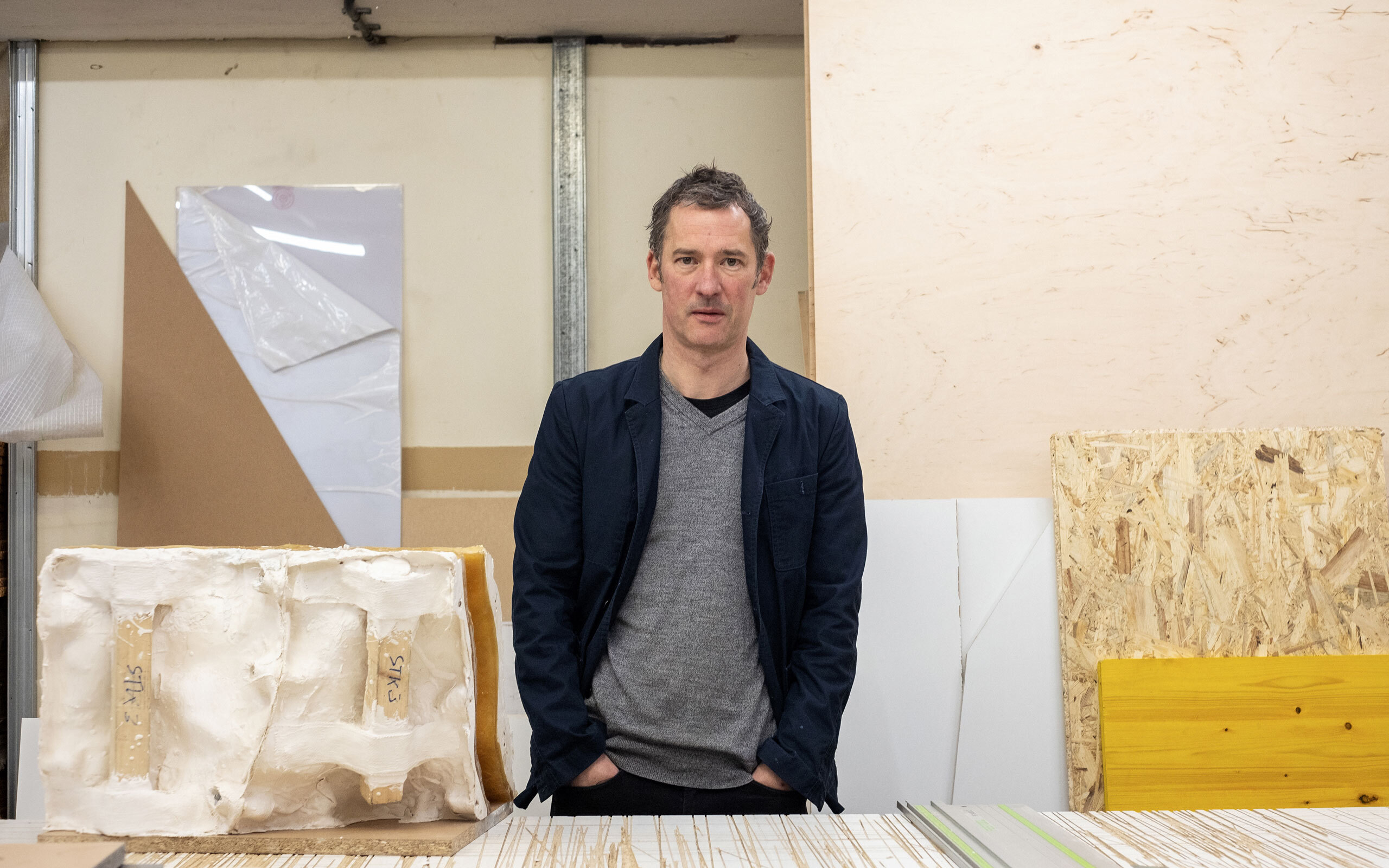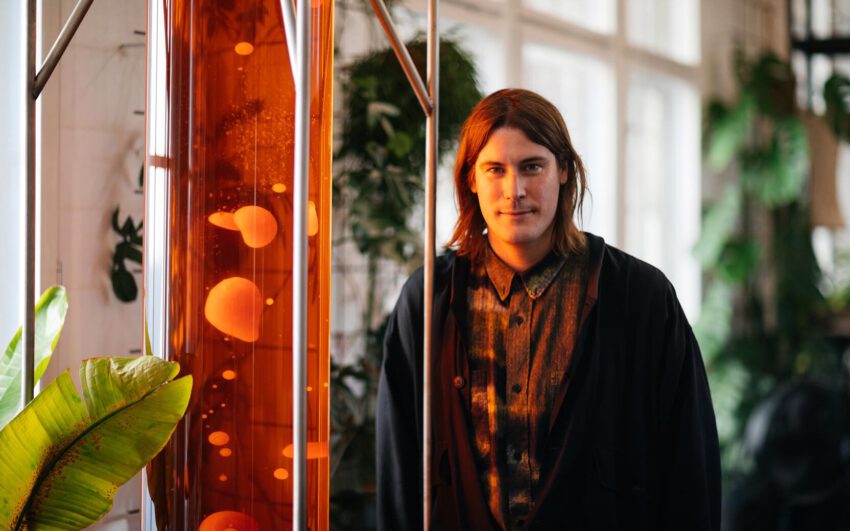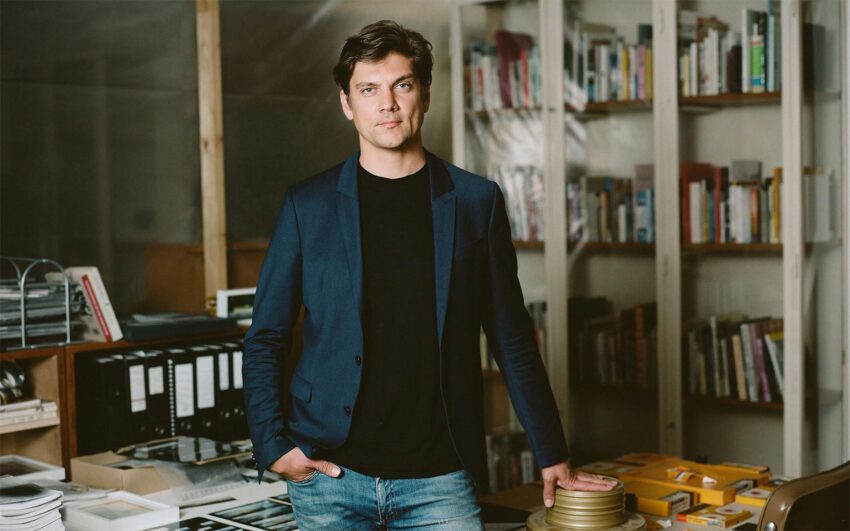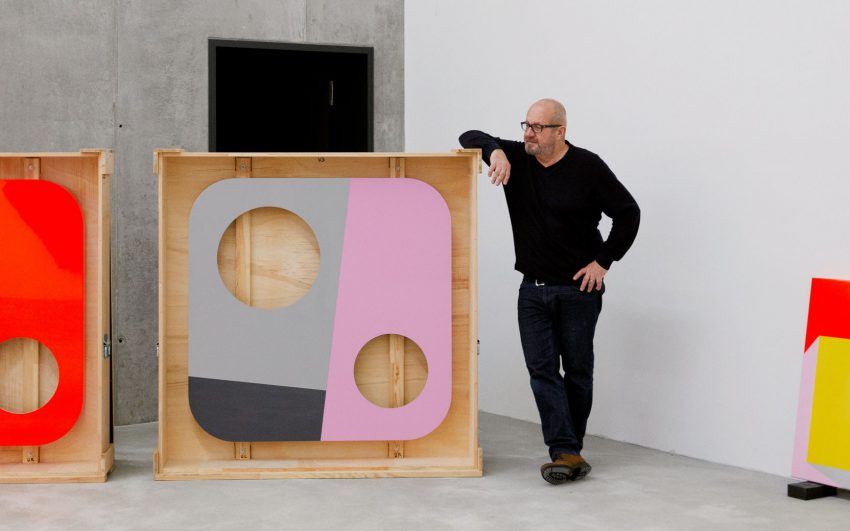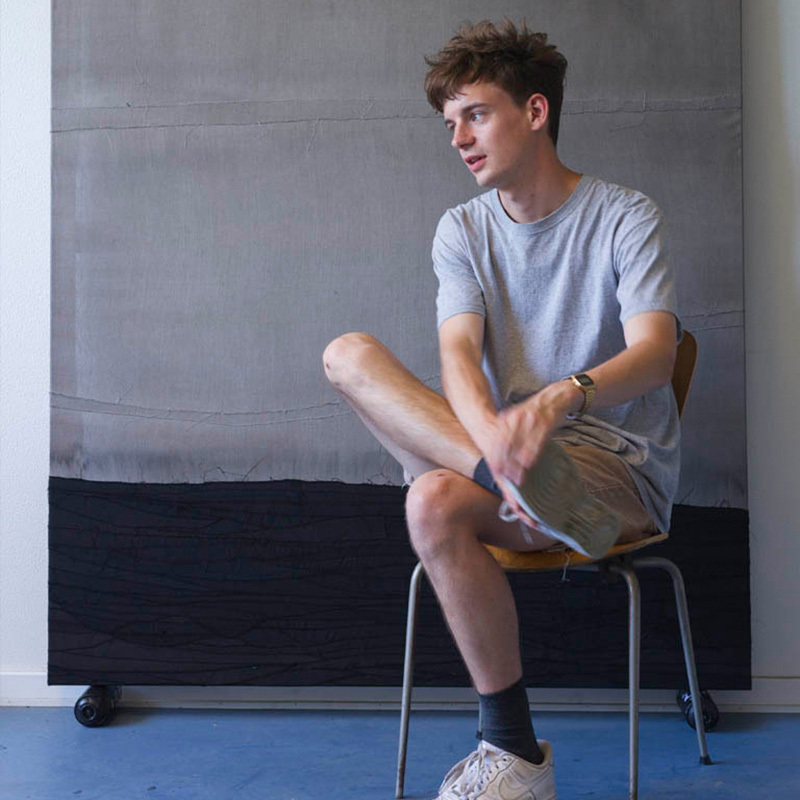Thrust, jerked, thrown, wrapped, rolled – in Christoph Weber’s hands, concrete, the commonplace material par excellence, finds constantly new and surprising forms. His objects move as if naturally between the expended brutality and the unexpected poetry of the material. During the interview in his spacious studio in Vienna’s Favoriten district, the artist tells us how he approaches the contradictions of concrete and how he works beyond them.
Christoph, your art has something earthbound to it. Could one put it that way?
It definitely has a certain grounded quality to it, plus its weight and the pull towards the earth, plays a role of course. But above all, I’m interested in the contrast between the solidity and the fragility of the material. I look for contradictions, that is why I like to use concrete, as Adrian Forty put it so well, “concrete is a material that constantly defies classification.”
Concrete is typically characterized by its robustness. What other aspect would you want to show?
Concrete does stand for robustness, but at the same time it is also quite brittle. I intend to fight against the gray, dull impassivity that concrete represents. To do that, I break it and try to dominate it. Or I manipulate it in its fresh, still very soft, clay-like state. Or I possess it instantly in such an almost fluid state, that as it sets, the fragility is in the foreground; this way, I don’t have to break the concrete first in order to create spatial tension through contrast.
It sounds as if concrete’s acknowledged strength makes it a symbol for you of human hubris and our urge to create absolutes.
Exactly! Concrete is also one of the materials that mark the Anthropocene epoch. From a geological point of view, it is already clear that concrete – along with perhaps nuclear energy – is the sign of our times and will be left behind like a new kind of stone. We produce an insane amount of concrete: 27 billion tons annually. After water, concrete is the second most used material in the world. Jan Zalasiewicz is a renowned geologist dedicated to this compelling topic.
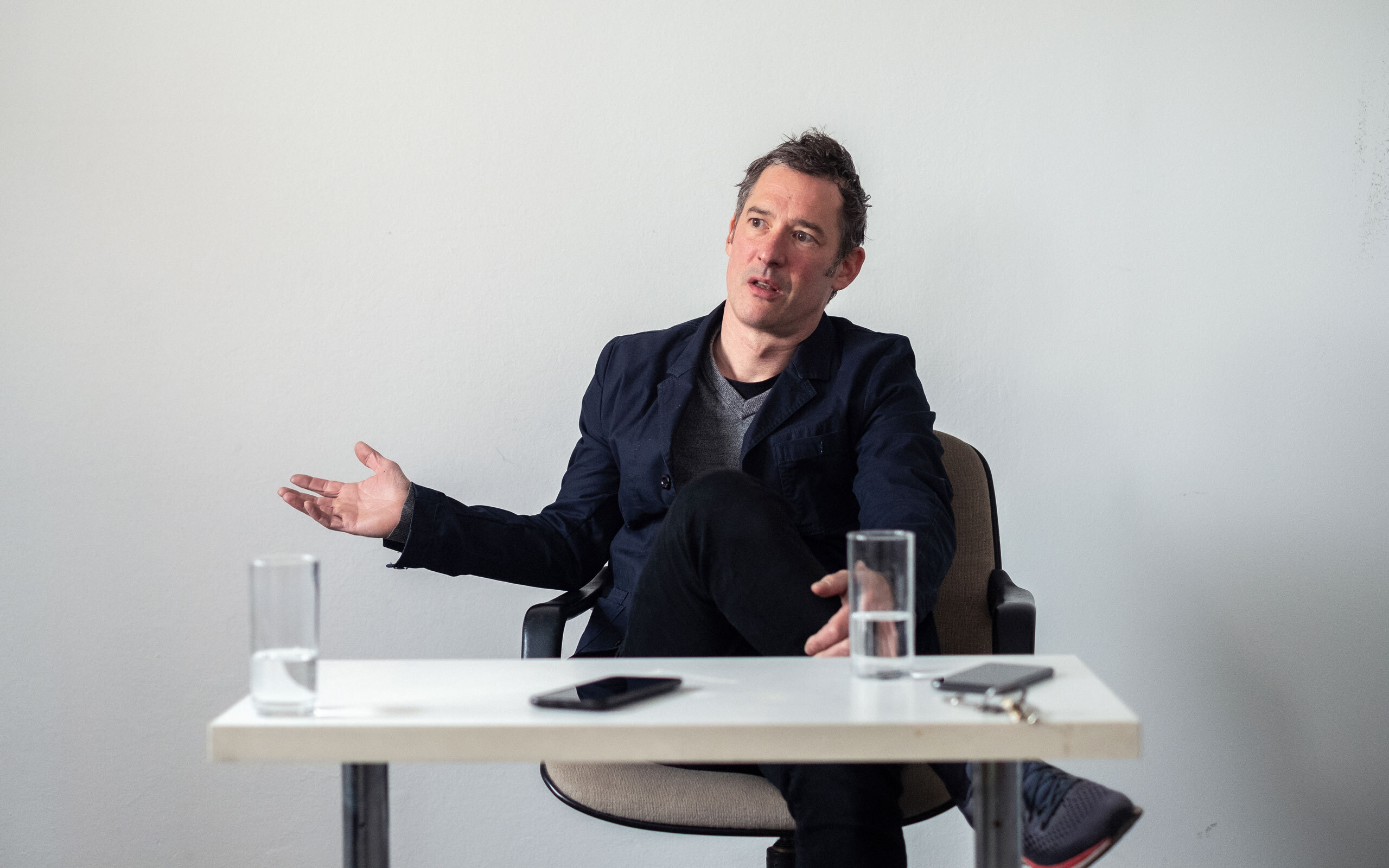
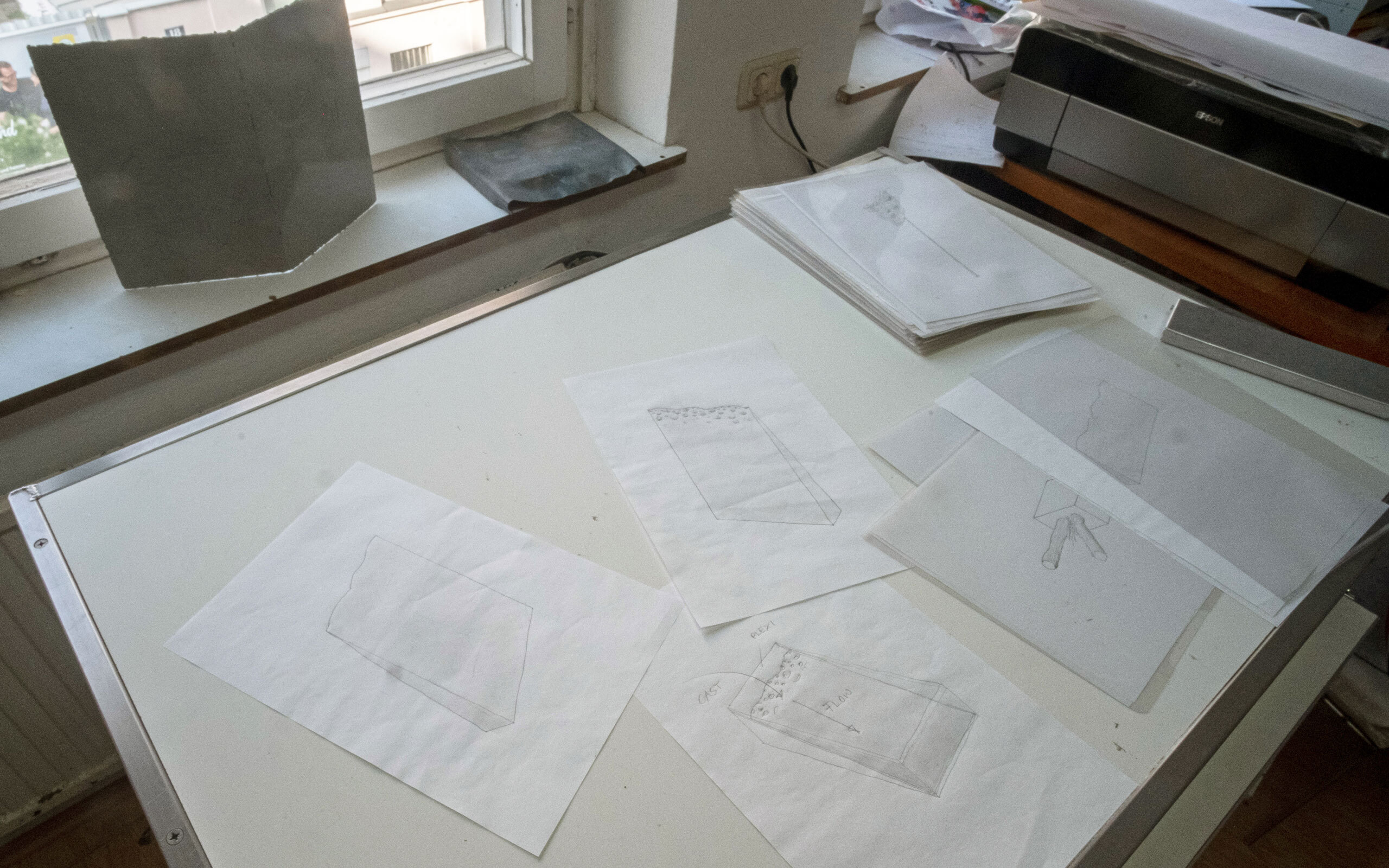
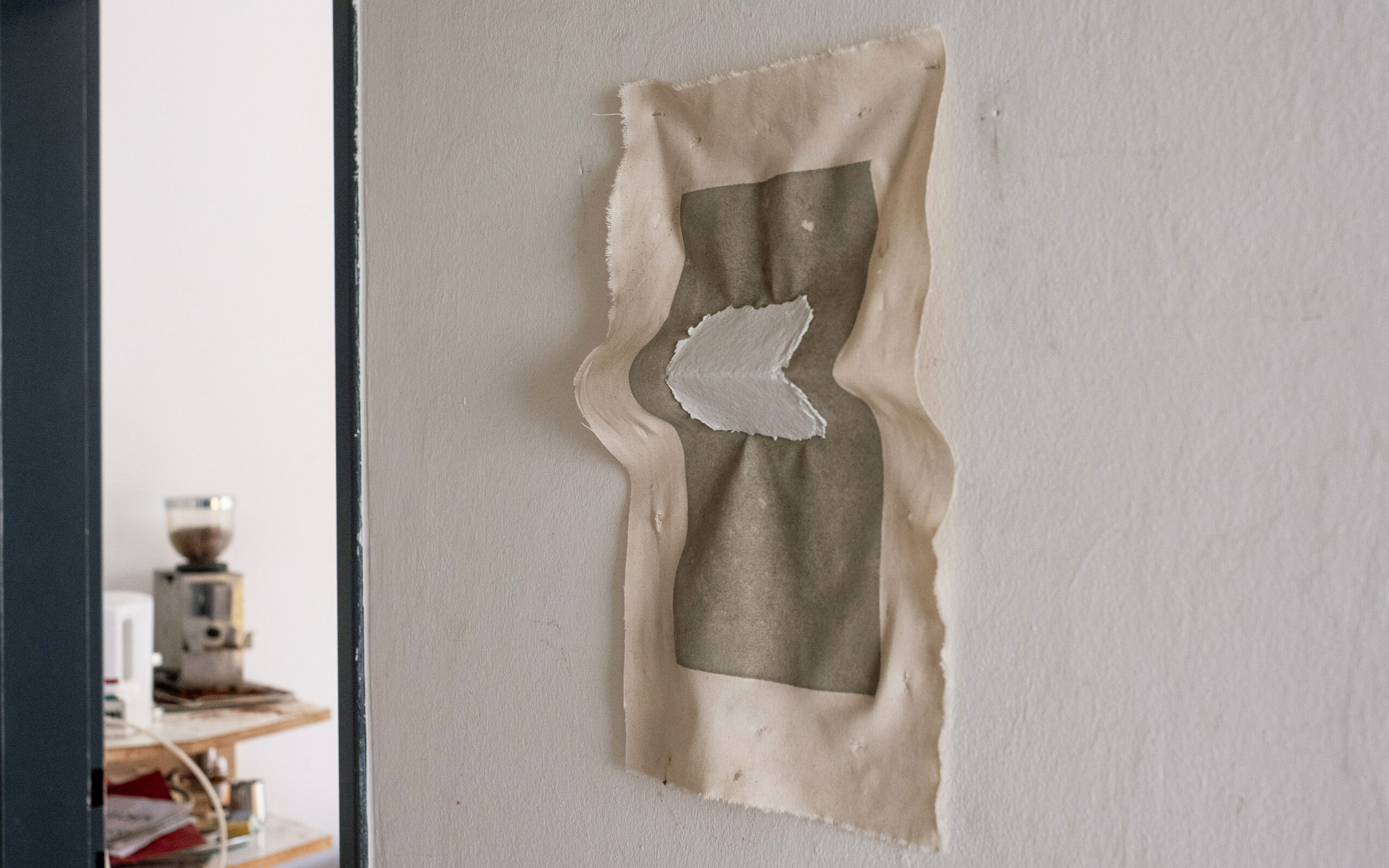
To move from the ecological impact of concrete to the artistic one: As a sculptor, you measure yourself against people who work with marble, the great metamorphic rock that nature has given to us. Is concrete the marble of man?
Quite the opposite – for me, concrete is more like anti-marble. Marble has always been the material for sculpture. Concrete is actually not a modern equivalent of it. Some of my works, which are shiny or fragile, flirt with the aesthetics of marble, but actually my initial aim was to criticize concrete as a material of modernism and, moreover, to question its meaning in today’s world. The goal is a fundamental investigation to filter out the agency of this material.
Do you remember how you began to deal with concrete and to think it through as a material?
It was triggered by my preoccupation with the geopolitical crisis of the Middle Eastern conflict. My first concrete breaking works therefore take revenge, so to speak, on this material that stands so much for the supremacy of the West. The desire to fight an industrial society that seals itself off with massive barriers was my trigger for destroying concrete. That led me to a kind of dissection of the material that also showed the softness of concrete. But once you start working with concrete, you realize how incredibly fragile it can be. So, over several years, I have developed a vocabulary in which different aspects of the entire bio-geo-chemical cycle always come to the fore.
What interactions with the material has that led you to?
At the moment, it’s the relationship between stone and concrete, which for example, I’m working on together with Nikolaus Eckhard on a project in Israel. But the whole nature-culture continuum – Rosi Braidotti talks about it in her book The Posthuman – is incredibly exciting for me. What is natural and what is artificial about the material? Concrete is 99 % natural materials, at the same time it is highly artificial, not least because resource extraction is often heedless and also it’s unsustainable because of the quantities involved. That’s a big discussion that increasingly concerns me. In addition to this, what has always fascinated me is the difference between external appearance and internal life. That’s another reason why, out of psychoanalytic curiosity, I have always liked to break open concrete to see what is actually inside. But as soon as I break it open, the inside has already become the new outside! I have also tried to depict various aspects of this confrontation with a simple gesture, as for example described and shown in ‘Close Disclose’ which appeared in a 2020 edition of Collectors Agenda.
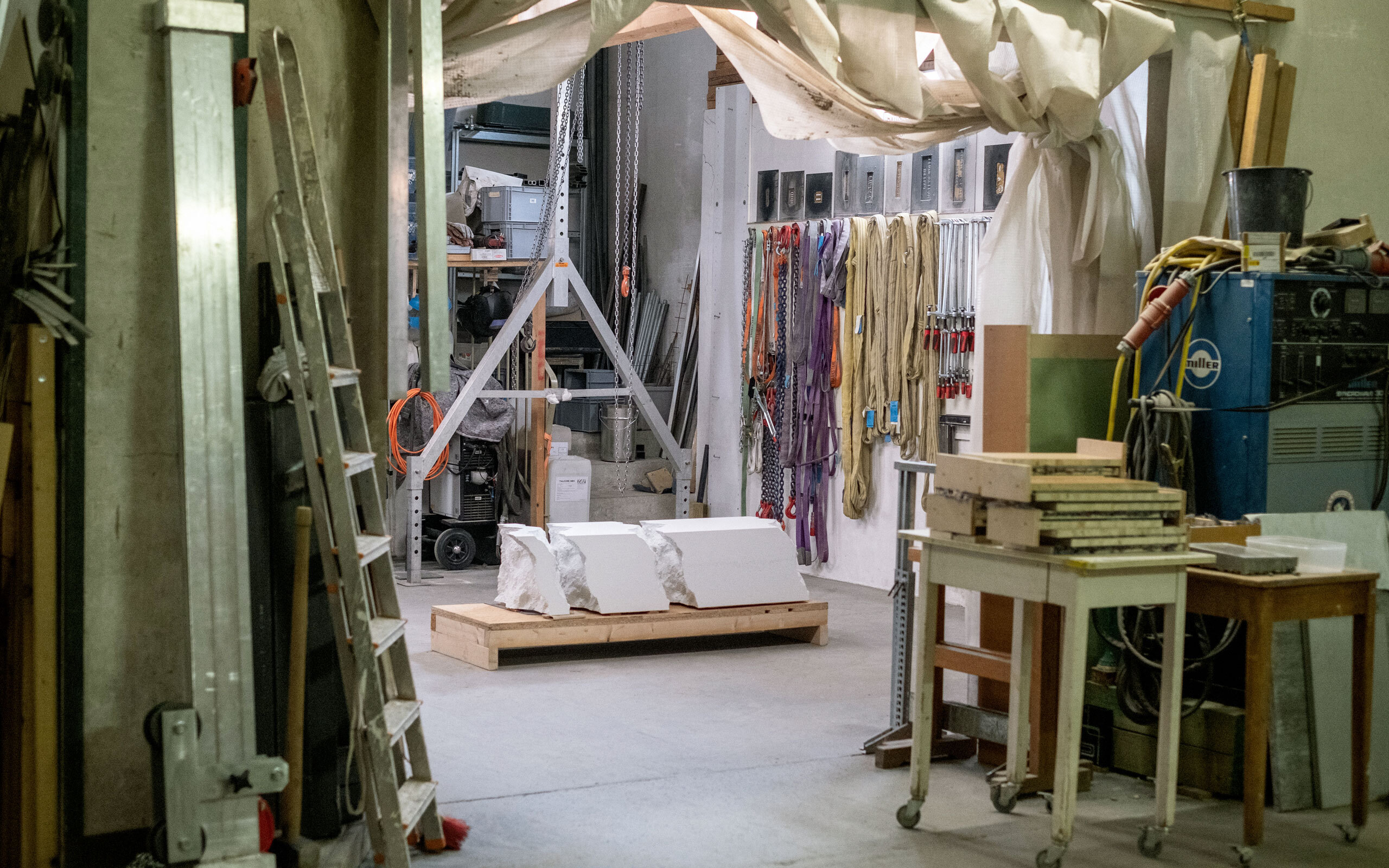
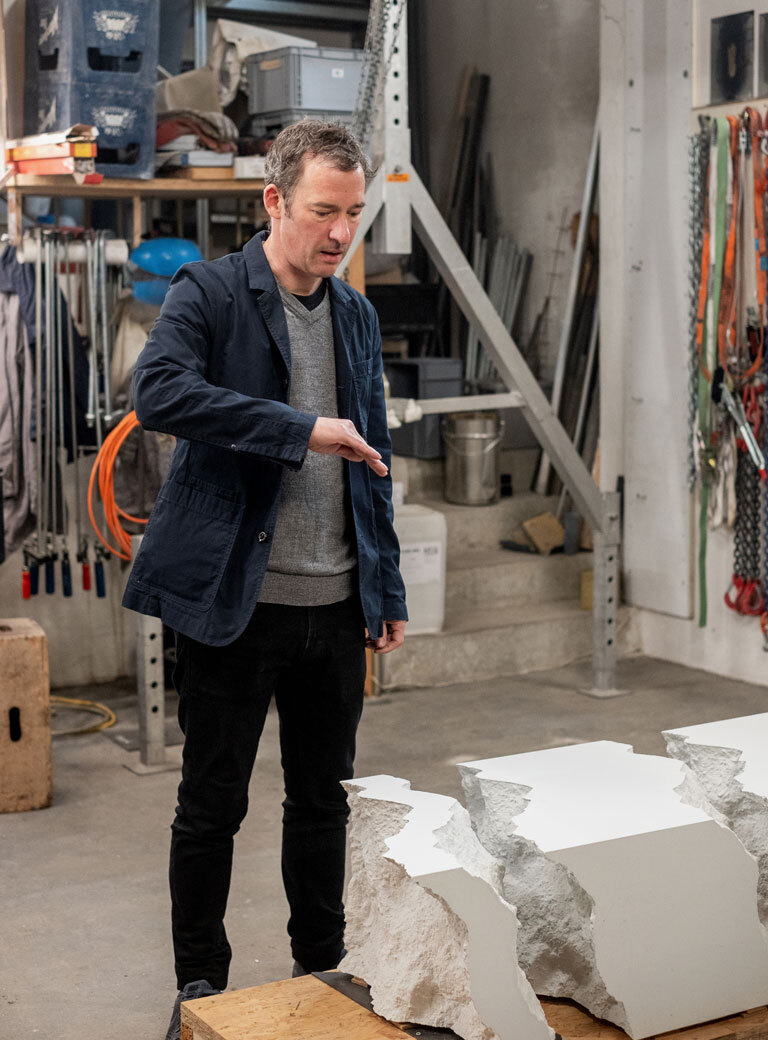
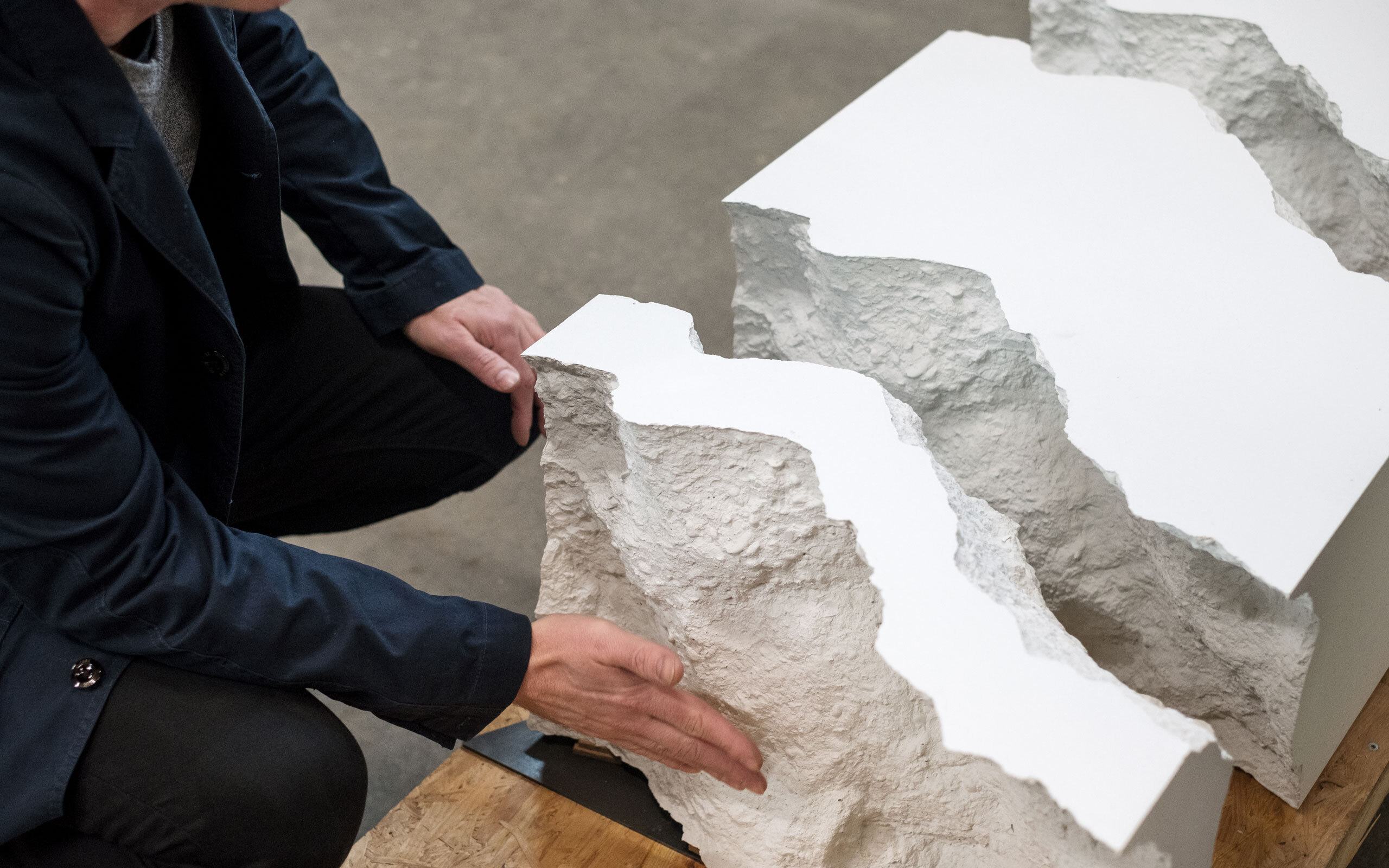
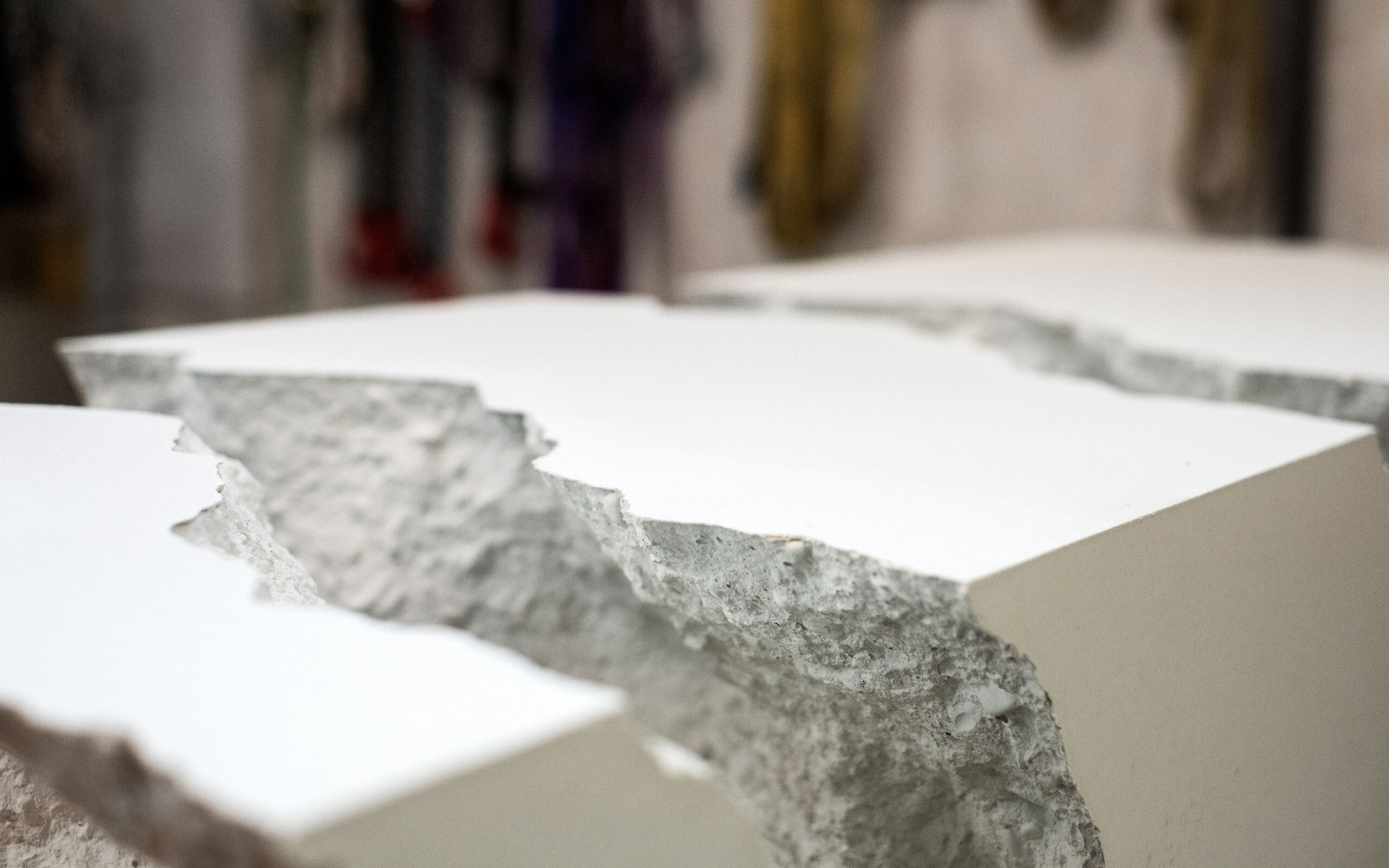
Is the goal, especially in your more process-oriented works, to give concrete its own expression beyond the usual perception?
I have had a strong desire to do away with the narrow form into which the perception of concrete has been reduced. What happens when it has been released? Usually concrete exists as petrified human action. What happens when it is let go? Usually concrete is petrified human action. All modernism was created on the drawing board and then cast in concrete. I contrast this with works like Concrete (rolled), where the material to a certain degree seeks its own form.
That sounds as if it would all work by itself. Actually working with concrete is a huge logistical challenge. Is a certain daily struggle the price you have to pay for large-scale concrete objects that may weigh many tons?
Quite. Moving the weight also requires increased concentration, which is extremely good. Concrete requires you to work in a very deliberate way. It can also be very satisfying to simply move a piece from A to B or turn it over to take a different position. Sculpting really becomes a fulfilling activity that way. However, it is always a struggle – even though I now have a forklift.
What does the production of one of your objects in the studio actually look like?
First, I calculate what kind of mixture is needed. How quickly should the concrete harden? This depends on whether or not I want to manipulate the casting while it is still pliable. Then it’s off to the woodshop: There, I build a mold that I have to be able to disassemble while the casting is still soft. The nice thing about working with fresh concrete castings is that it is relatively quick and you don’t have to be very precise. So it can be that the idea for a work comes up in the morning and it is subsequently finished in the evening. For a few years, I had a lot of fun working very quickly: Build the form, cover it, mix it in, and then manipulate it again an hour later. In the meantime, I sometimes work quickly, sometimes slowly, I sometimes work without any concrete at all, or even on work that is only marginally related to concrete.
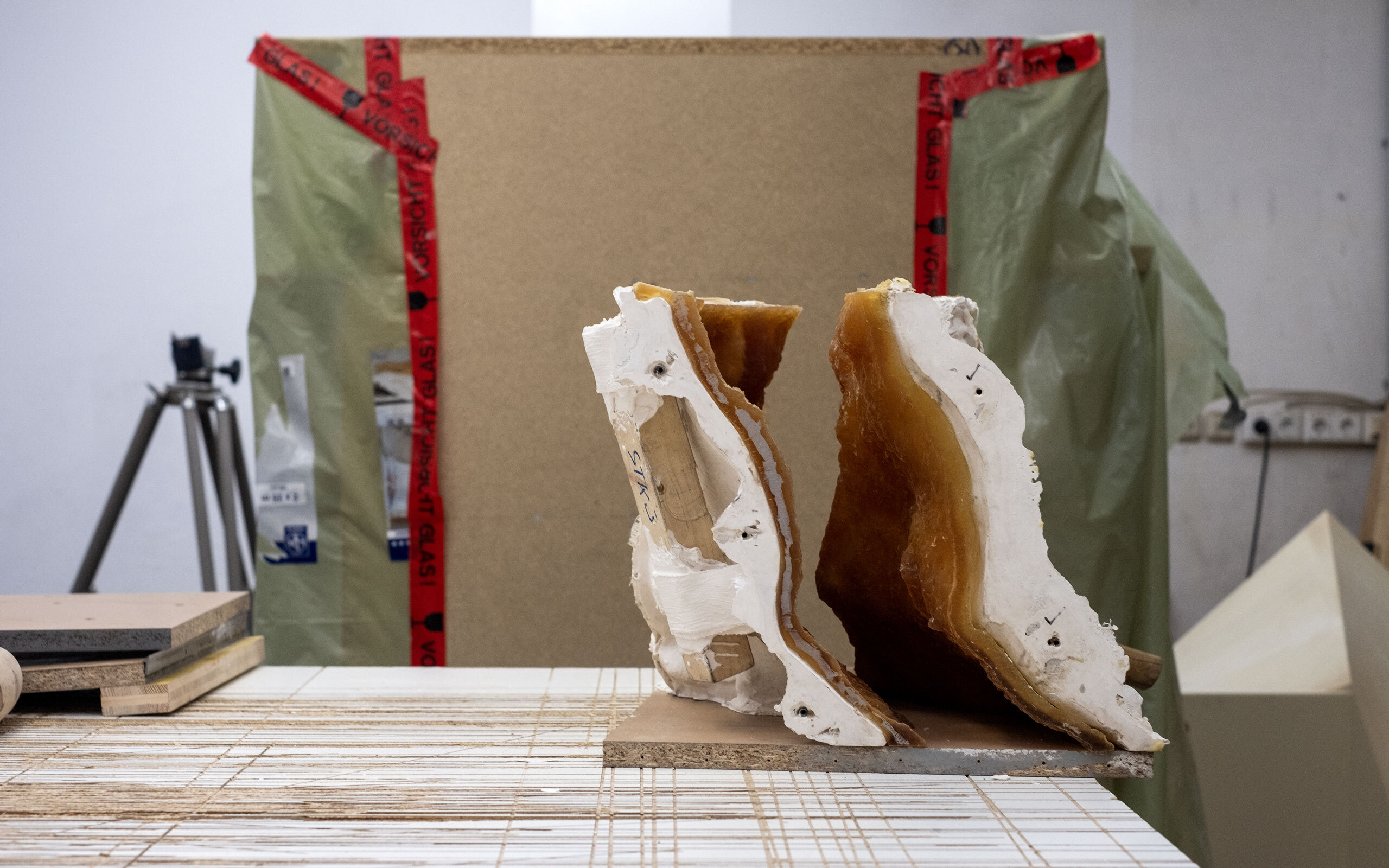
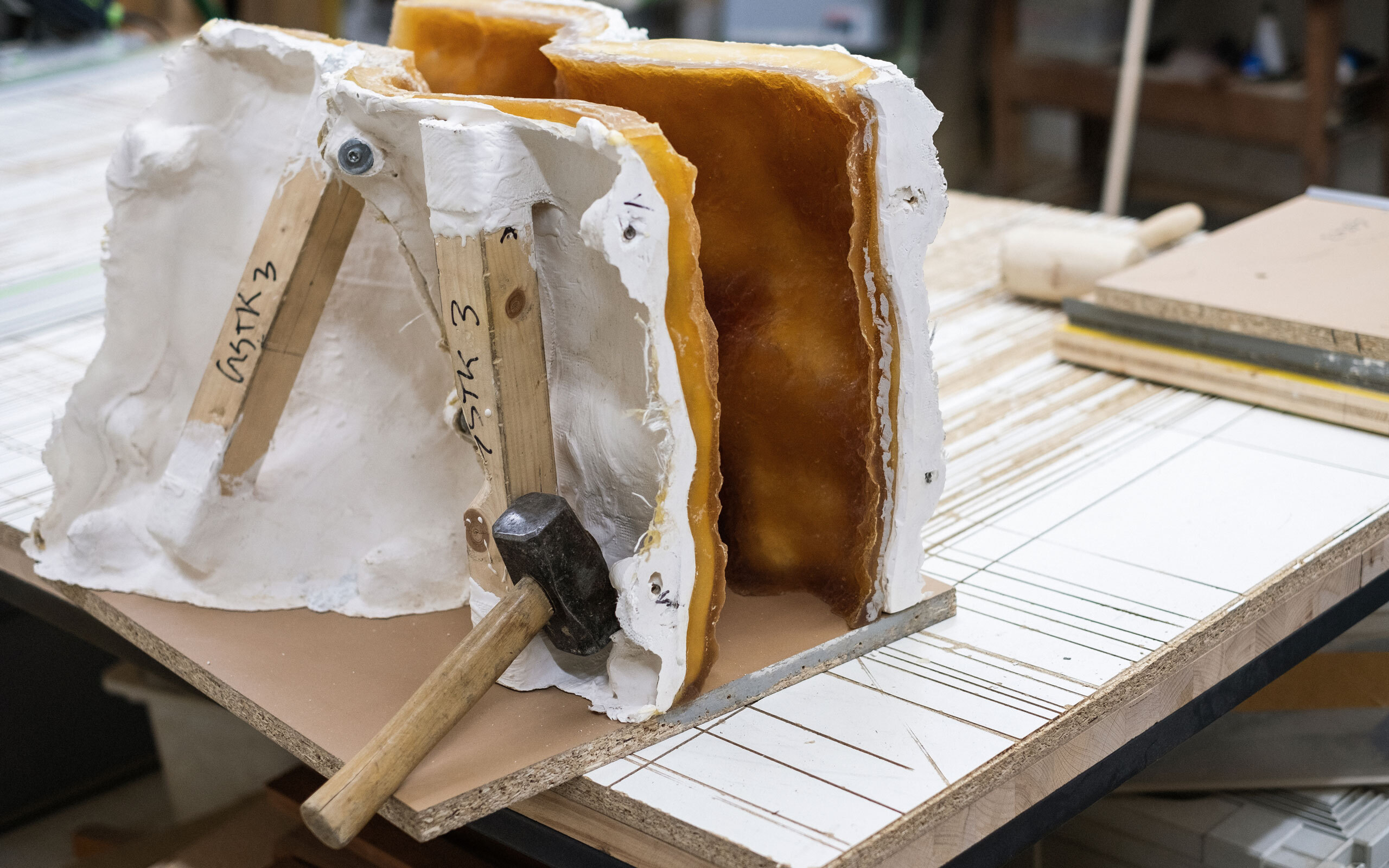
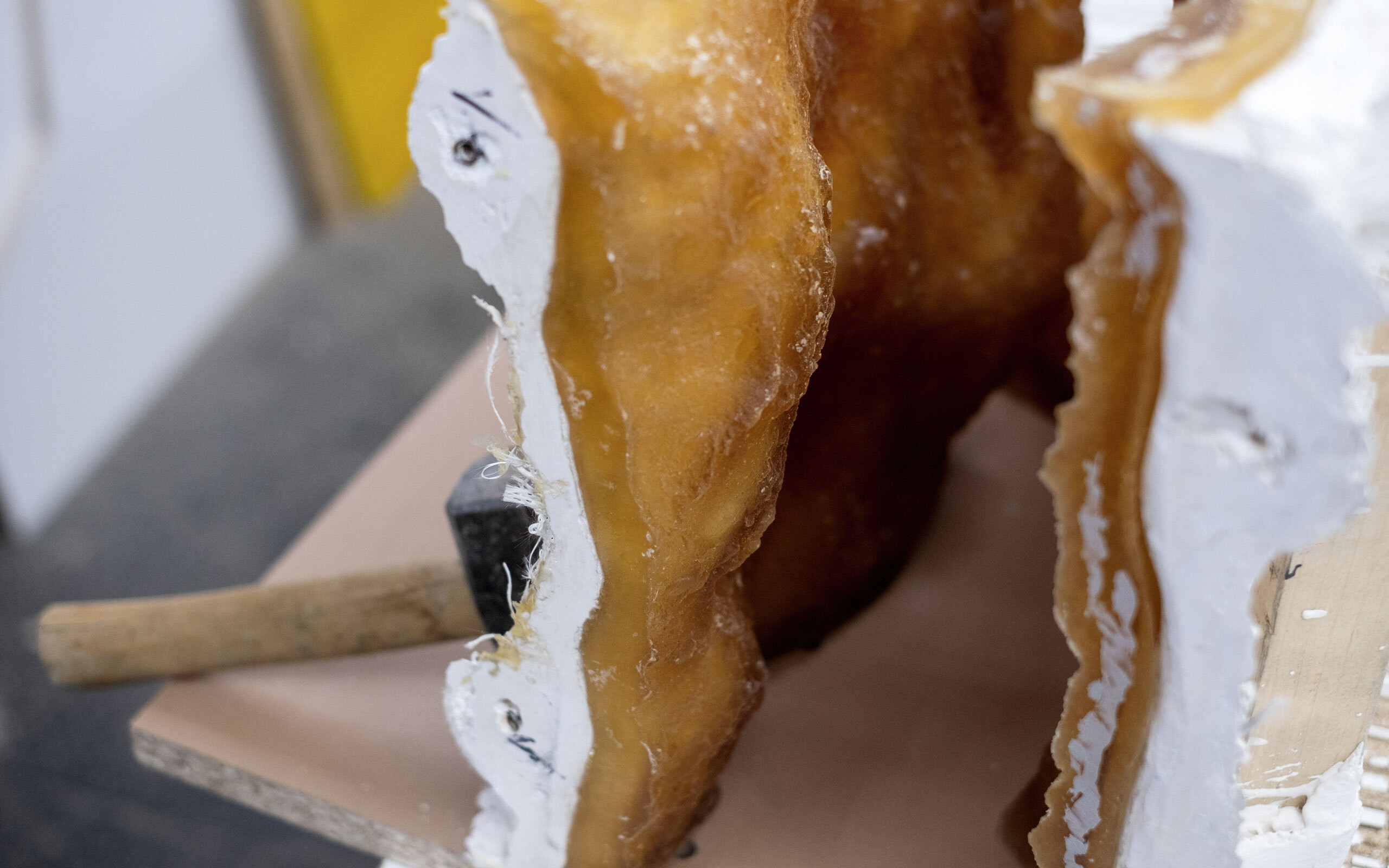
With three-dimensional objects – and your sculptures are sometimes quite large – the context always plays an important role. How does the environment have to be that your work opens up in the best possible way?
Most of the time it is the case that the place in which I am to work or am allowed to work already exists. Accordingly, I then more or less spontaneously develop pieces that respond to the place. Seen in this way, the gallery space is a space I have learned to deal with and where I can develop well. But that doesn’t mean that it has to be a white cube. Some works are formally so strong that they can also work in a dominant space, but ultimately the white cube is the best place to concentrate on the perception of a work.
So if someone were to step into our hypothetical white cube where one of your works is exhibited, what effect would you hope would be triggered in that person?
Ideally, the tension between fragility and weight as well as massiveness – not to mention brutality – should be palpable in the space. Quite often, this creates a vibration in the room that draws its power from this contradiction. This gives my works their presence in space. This presence is the first point of contact with my work and exposes for me important levels of meaning – political, historical, ecological, and material-inherent symbolism.
Was it always clear to you that you wanted to become an artist? How did this desire develop?
For me, it was a combination of photography, which I had been involved with since my childhood, and literature. Thomas Bernhard was a strong influence, which made me turn away from photography. One would think that I should have made films out of the combination of photography and literature, but it turned out differently. At the Academy of Visual Arts in Leipzig, where I had started with photography, I finally got into a class for fine arts. There my work developed in the direction of installation and object. I then wrote my final thesis on the dematerialization and rematerialization of conceptual art.
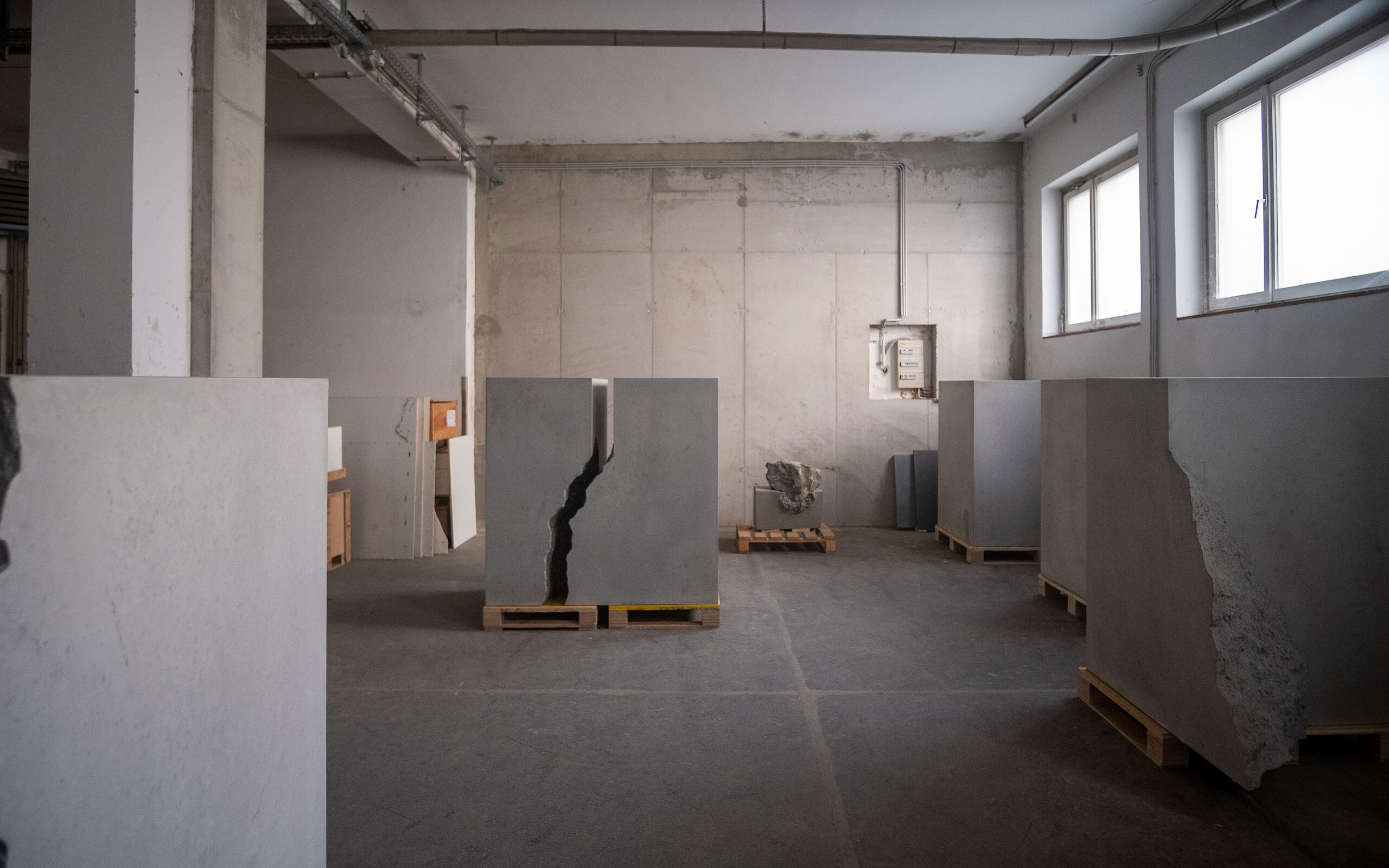
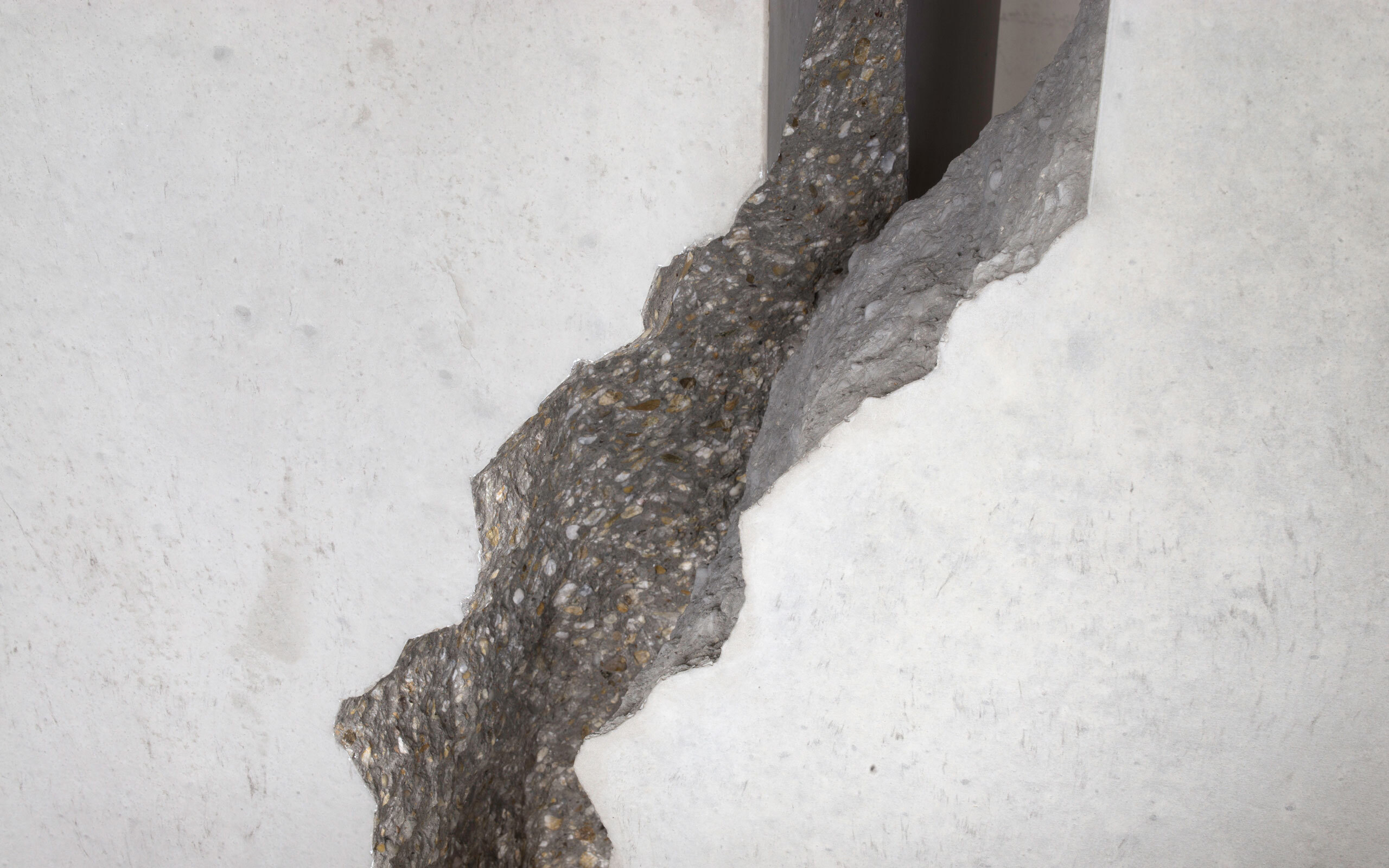
Untitled (Gegenstück), 2018-2020, Concrete, 2 parts, overall 130 x 135 x 90 cm, Courtesy Galerie Jocelyn Wolff, studio view, Photo: Christoph Weber
As someone who comes from Vienna, went abroad to study, and eventually returned: what is it to you that distinguishes the city as a place to make art?
It was a relatively pragmatic decision to return to Vienna from Leipzig, rather than, say, going to Berlin. It was much easier for me to find a well-paid job in my hometown. And that’s where it stayed. My first gallery was neither in Austria nor in Germany, but Jocelyn Wolff in Paris. Vienna is the ideal place for producing – especially for people who have lived here for a long time and have found a reasonable studio. The size of the city is ideal. You can get everything, but it doesn’t take forever to get it. And in the meantime there also exists a very lively art scene. Twenty years ago, Vienna was still quite provincial with maybe two off-spaces and ten established galleries.
In your environment, are there artists to whom you feel attached and whose work you appreciate?
I find it indeed very nice to grow together with colleagues of my generation in Vienna. Just around the corner, for example, Andreas Fogarasi, with whom I am good friends, has recently opened his studio. Then there are Judith Fegerl, Andreas Duscha, and Christian Kosmas Mayer. Also Sonia Leimer, who, like me, is represented at Galerie nächst St. Stephan. To make the circle a bit more international: Ján Mančuška, who unfortunately has passed away, but with whom I shared a residency and had an intensive exchange on the topic of concept versus materiality. From my time in Leipzig there are the filmmakers Clemens von Wedemeyer and Maya Schweizer.
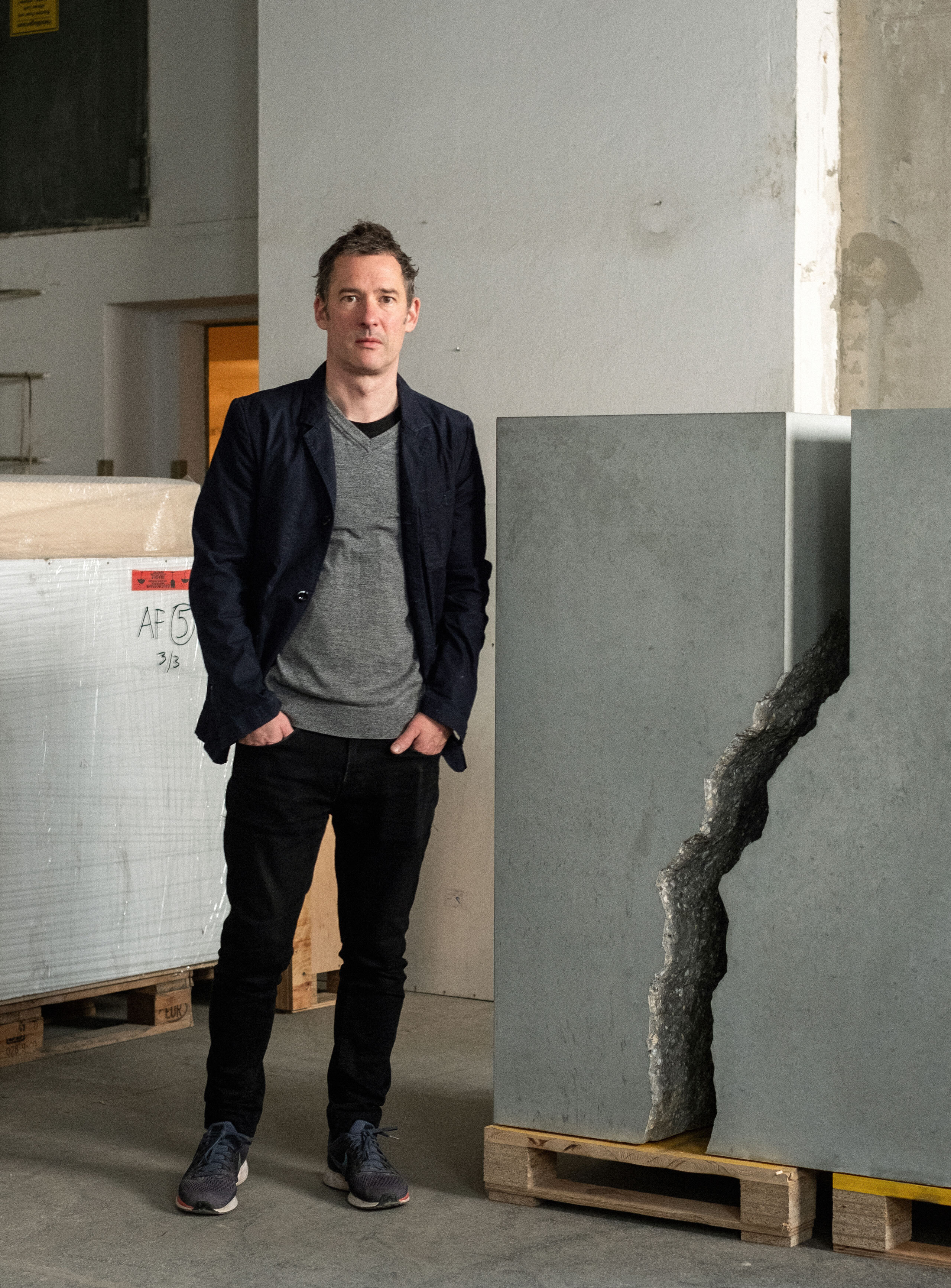
Finally, what are you working on at the moment?
There are several different projects. Via Zoom I have just been in Israel where I am involved with the Artistic Research project together with Nikolaus Eckhard, which I already mentioned briefly. This project is inspired by the concept of the biblical stone, implying strength and resiliency as Alona Nitzan-Shiftan’s quote “Israel is a nation of stone but a state of cement.” Another research project is concerned with green-washing and marketing concrete as an environmentally friendly building material. Results of this research will be on display at MAK at the Vienna Biennale for Change. Furthermore, there is a project for the Sculpture Park in Graz to be realized in in 2021, and a competition in Linz for a memorial for refugees who have died since 2015. This is the immediate work – challenges! – that I am really looking forward to. And recently, the Centre Pompidou purchased the work Crack Stop Motion, for which I am still developing a photographic extension.
Well, you certainly seem to have the feeling that there is enough material with regard to concrete to work with for many years, don’t you?
In the meantime my investigation has matured and is drawing wider circles. From this extensive research, individual works can then arise again and again. Among other things, the serial work Crack Stop Motion. The friction between abstraction and reality has also arisen within my occupation with concrete from the handling of the material, but goes beyond that. The casting versus the manipulation of the fresh material, that is the concentration minimal versus post-minimal, cast versus uncast. Somehow they are all formal correspondences of the complexity of the material – and I like such contradictions.
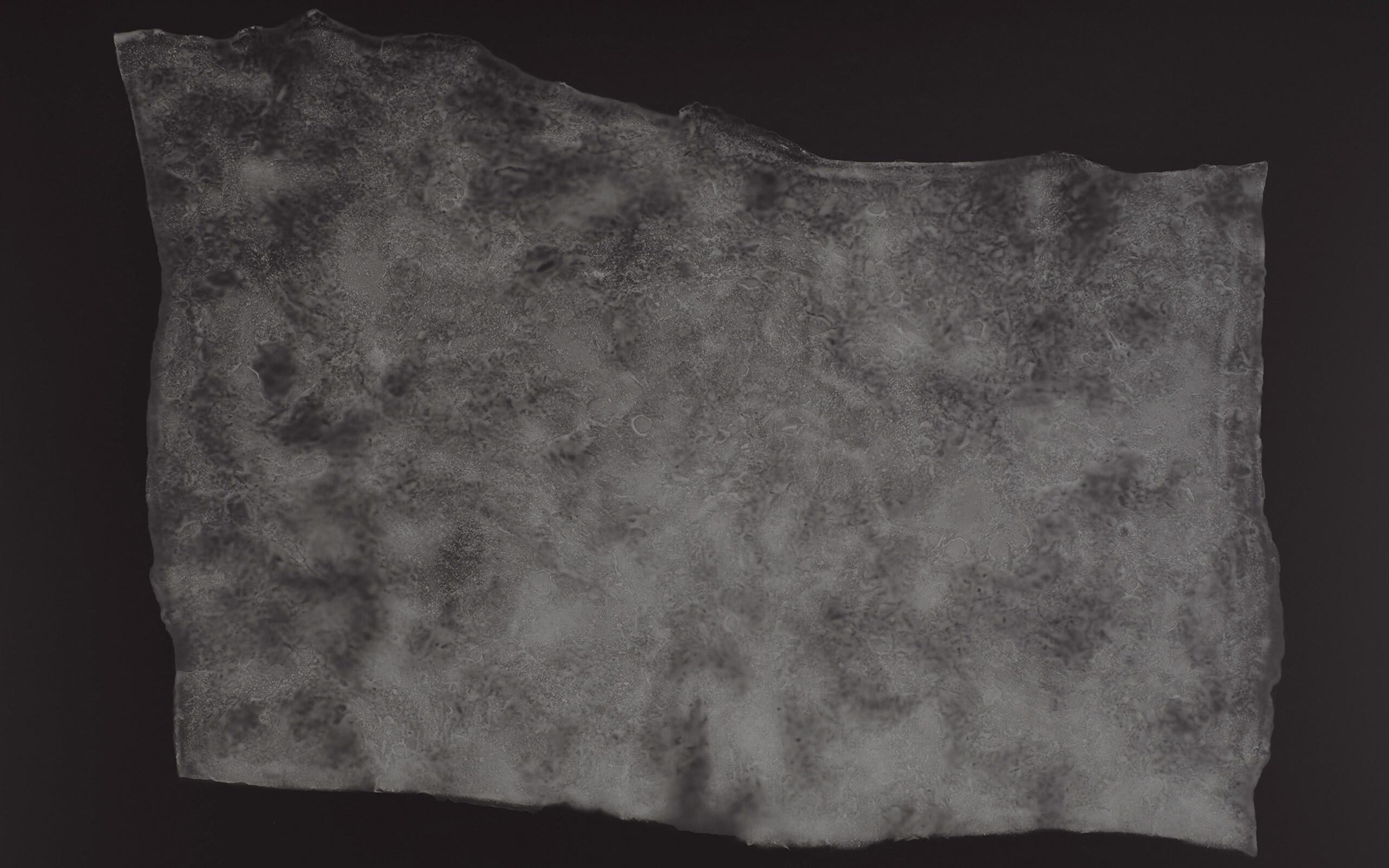
Crack Stop Motion Contact Sheet, Photo work, Photo: Christoph Weber
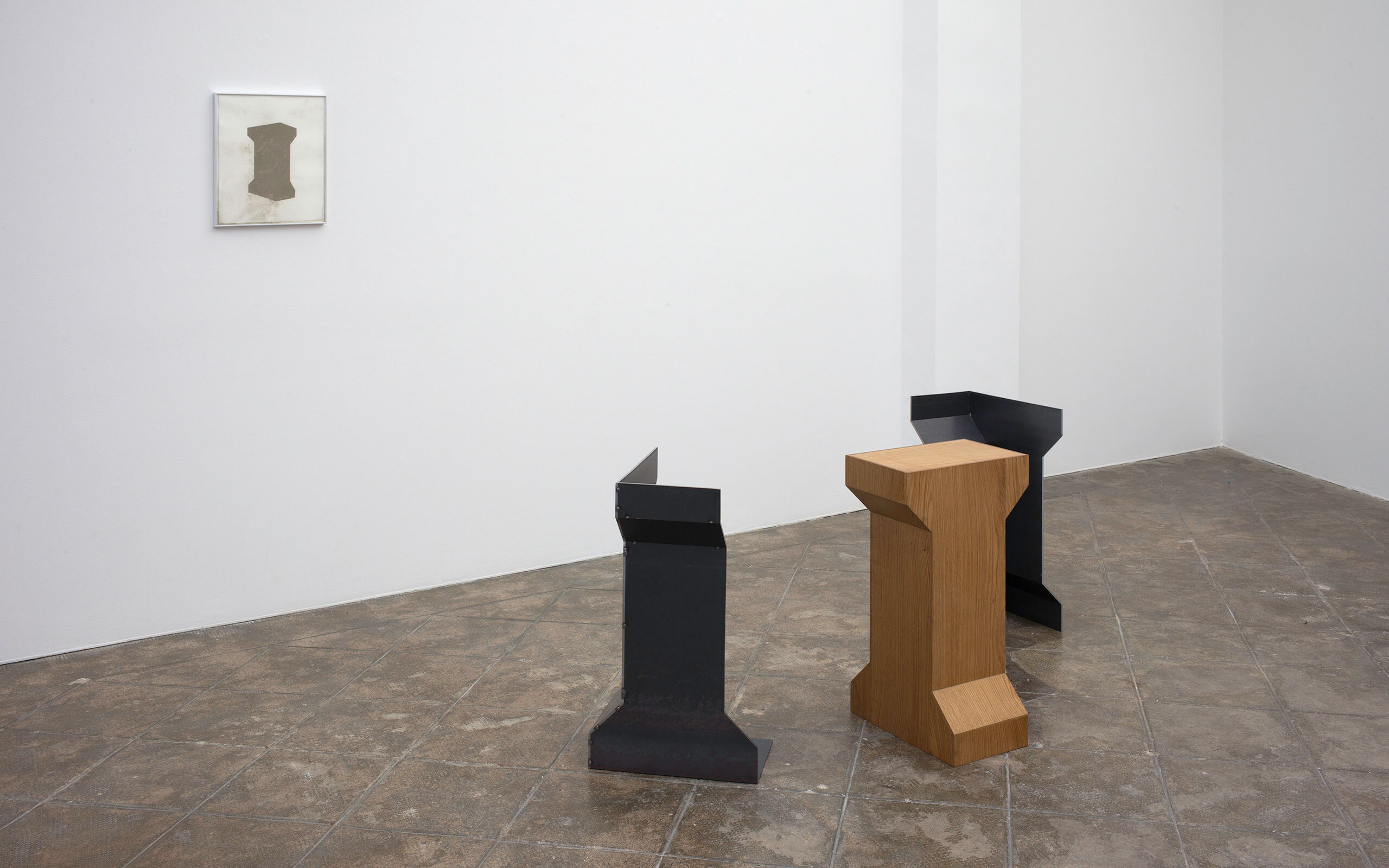
béton brut matrix, 2017, wood, steel, 72,6 x 161 x 80 cm; Drawing: Pencil, cement, glue on paper, 41 x 33 cm, Courtesy ProjecteSD, Barcelona, Exhibition view: On Fold, ProjecteSD, Barcelona, 2017, Photo: Christoph Weber
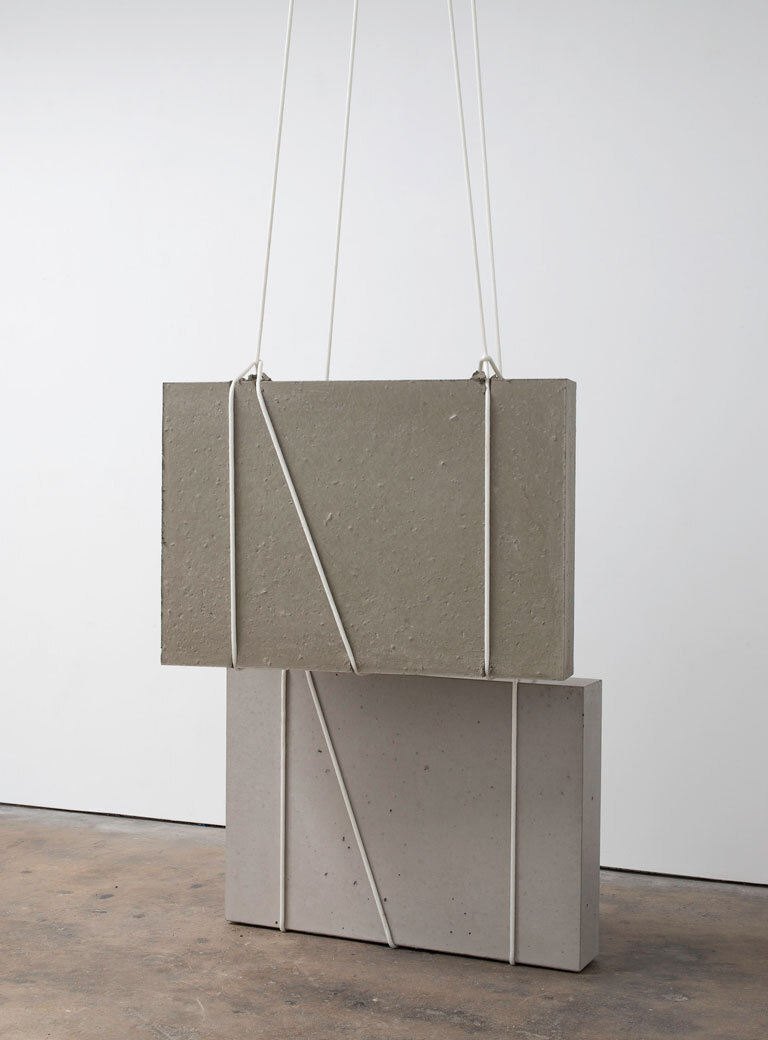
Cast and Uncast, 2018, Concrete, rope, Dimensions variable, each slab 70 x 100 x 15 cm, Courtesy Galerie Jocelyn Wolff, Exhibition view: Contact, Ibid, Los Angeles, 2018, Photo: Christoph Weber
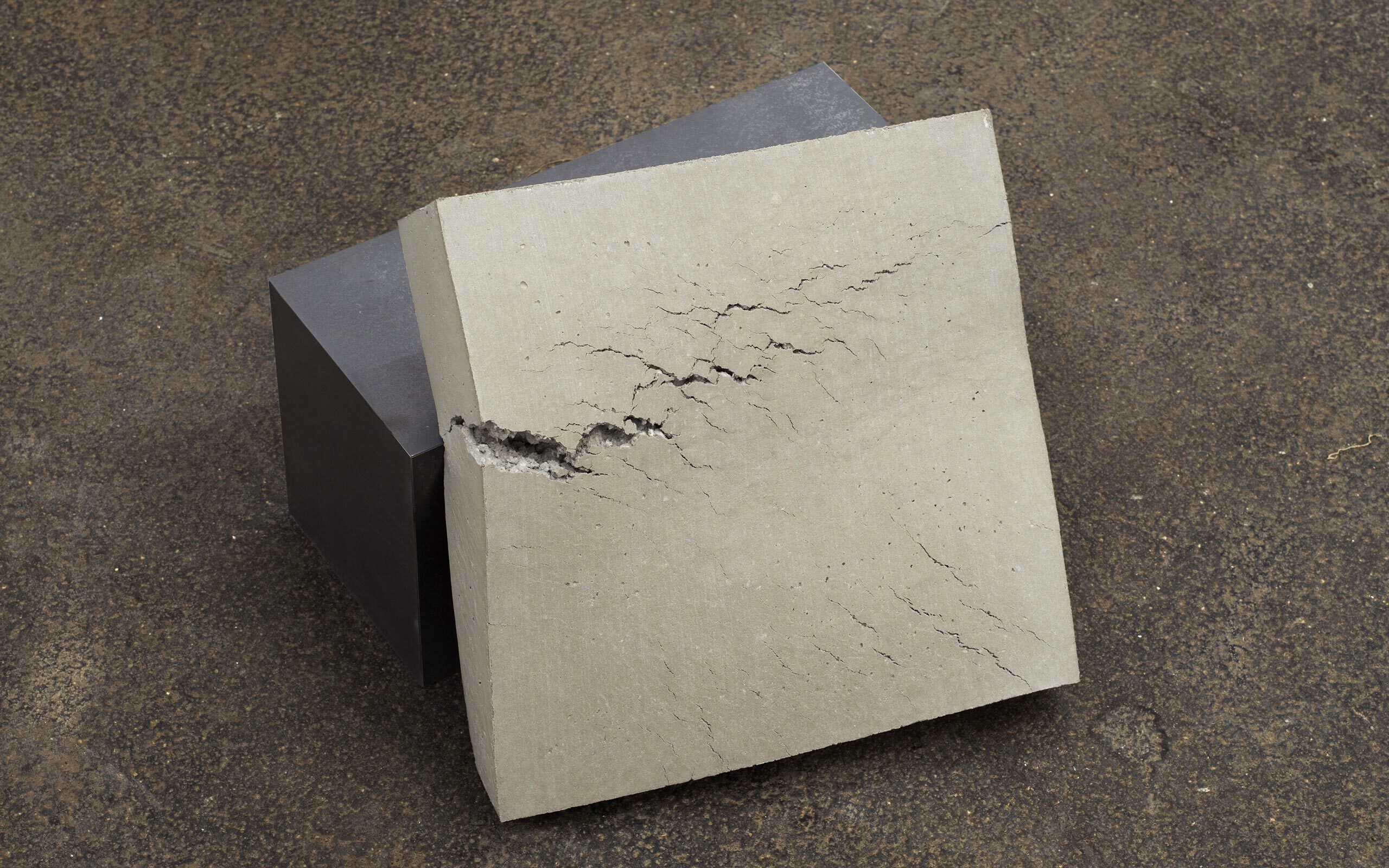
not yet titled, 2019, Concrete, steel, 34 x 40 x 40 cm, Courtesy Galerie nächst St. Stephan - Rosemarie Schwarzwälder, Studio View, Photo: Christoph Weber
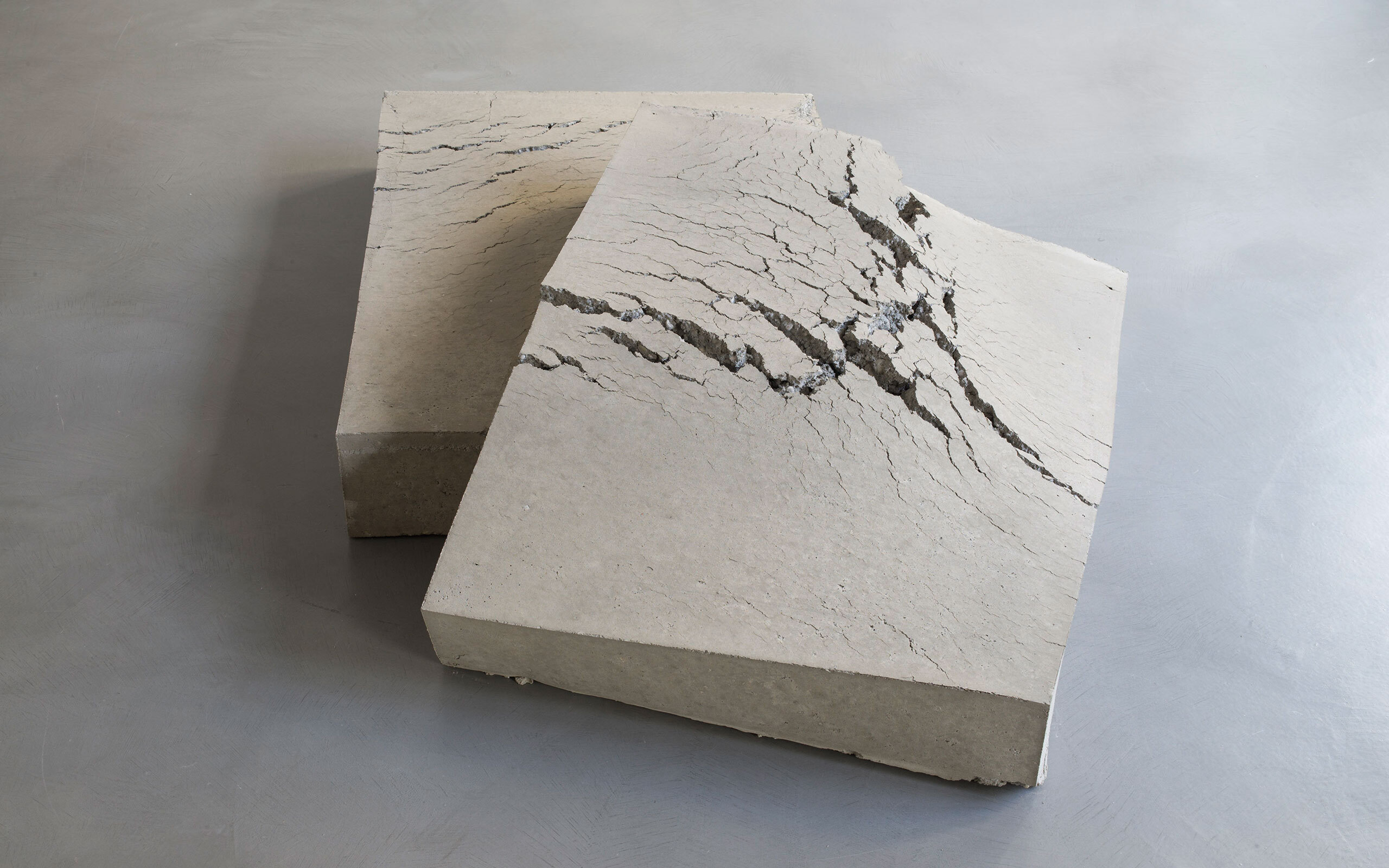
Beton (gestoßen), 2016, Concrete, 2 parts, 30 x 155 x 110 cm, Courtesy Galerie Jocelyn Wolff, Exhibition view: Carton / pierre, Galerie Jocelyn Wolff, Paris, 2016, Photo: Christoph Weber
Interview: Gabriel Roland
Photos: Maximilian Pramatarov


